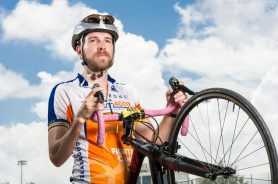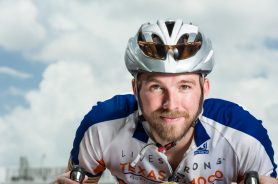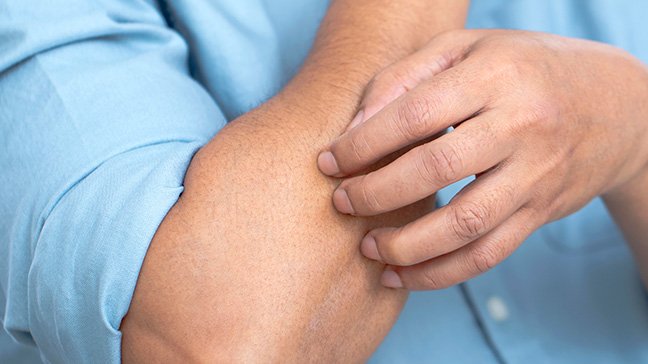Ewing's sarcoma survivor stays active by cycling
- Diseases
- Acoustic Neuroma (16)
- Adrenal Gland Tumor (24)
- Anal Cancer (70)
- Anemia (2)
- Appendix Cancer (18)
- Bile Duct Cancer (26)
- Bladder Cancer (74)
- Brain Metastases (28)
- Brain Tumor (234)
- Breast Cancer (726)
- Breast Implant-Associated Anaplastic Large Cell Lymphoma (2)
- Cancer of Unknown Primary (4)
- Carcinoid Tumor (8)
- Cervical Cancer (164)
- Colon Cancer (168)
- Colorectal Cancer (118)
- Endocrine Tumor (4)
- Esophageal Cancer (44)
- Eye Cancer (36)
- Fallopian Tube Cancer (8)
- Germ Cell Tumor (4)
- Gestational Trophoblastic Disease (2)
- Head and Neck Cancer (14)
- Kidney Cancer (130)
- Leukemia (342)
- Liver Cancer (50)
- Lung Cancer (286)
- Lymphoma (278)
- Mesothelioma (14)
- Metastasis (30)
- Multiple Myeloma (100)
- Myelodysplastic Syndrome (60)
- Myeloproliferative Neoplasm (6)
- Neuroendocrine Tumors (16)
- Oral Cancer (102)
- Ovarian Cancer (178)
- Pancreatic Cancer (160)
- Parathyroid Disease (2)
- Penile Cancer (14)
- Pituitary Tumor (6)
- Prostate Cancer (150)
- Rectal Cancer (58)
- Renal Medullary Carcinoma (6)
- Salivary Gland Cancer (14)
- Sarcoma (238)
- Skin Cancer (300)
- Skull Base Tumors (56)
- Spinal Tumor (12)
- Stomach Cancer (66)
- Testicular Cancer (28)
- Throat Cancer (92)
- Thymoma (6)
- Thyroid Cancer (100)
- Tonsil Cancer (30)
- Uterine Cancer (86)
- Vaginal Cancer (18)
- Vulvar Cancer (22)
- Cancer Topic
- Adolescent and Young Adult Cancer Issues (22)
- Advance Care Planning (12)
- Biostatistics (2)
- Blood Donation (18)
- Bone Health (8)
- COVID-19 (360)
- Cancer Recurrence (120)
- Childhood Cancer Issues (120)
- Clinical Trials (628)
- Complementary Integrative Medicine (22)
- Cytogenetics (2)
- DNA Methylation (4)
- Diagnosis (238)
- Epigenetics (6)
- Fertility (62)
- Follow-up Guidelines (2)
- Health Disparities (14)
- Hereditary Cancer Syndromes (128)
- Immunology (18)
- Li-Fraumeni Syndrome (8)
- Mental Health (122)
- Molecular Diagnostics (8)
- Pain Management (62)
- Palliative Care (8)
- Pathology (10)
- Physical Therapy (18)
- Pregnancy (18)
- Prevention (936)
- Research (390)
- Second Opinion (78)
- Sexuality (16)
- Side Effects (616)
- Sleep Disorders (10)
- Stem Cell Transplantation Cellular Therapy (216)
- Support (408)
- Survivorship (328)
- Symptoms (182)
- Treatment (1788)
From Ewing’s sarcoma patient to medical student
3 minute read | Published September 13, 2017
Medically Reviewed | Last reviewed by an MD Anderson Cancer Center medical professional on September 13, 2017
I’ve always been good at math and science, so I’d given some thought to becoming a doctor, even as a teenager. Then cancer came along, and I got to see a lot of the inner workings of the medical field.
I was hooked. Medicine seemed like a great avenue for my talents and passions. And I wanted to give back and be part of the community that saved my life.
My Ewing’s sarcoma diagnosis
I was 17 years old when I found out I had cancer. One day in May 2009, I woke up with shooting pains in my right arm. Since I was the pitcher on my high school baseball team, I got it checked out by a sports orthopedist. He assumed it was tendonitis and gave me some anti-inflammatory medication.
The pain didn’t subside, so I got an X-ray. The doctor saw a shadow on my bone and ordered an MRI. We had an orthopedic surgeon look at those images, too. He ordered a biopsy. The results showed I had Ewing's sarcoma, a type of bone and soft tissue cancer.
‘Unparalleled’ experience at MD Anderson
My treatment consisted of 14 rounds of chemotherapy, with surgery smack dab in the middle. I had my chemo infusions at a local children’s hospital, but when it came time to have surgery, I wanted a second opinion.
I liked my surgeon, but I wasn’t really confident in his level of experience. So, I got some referrals and asked a lot of questions. Ultimately, I chose Valerae Lewis, M.D., at MD Anderson, because her experience is unparalleled. She’d done the operation I needed several times before and was very confident. And her confidence made us confident.
Maintaining functionality after surgery
My surgery took place at MD Anderson in August 2009. Dr. Lewis took all of my right radius out, except for a little stub down by my hand. Then, she recreated my wrist. Afterwards, I had seven more rounds of chemo, and I’ve been cancer-free ever since.
The radius is the bone on the thumb side of your forearm that allows you to rotate your wrist. So I can’t rotate my right wrist anymore, but I can still write and do everything else I need to do — including my 2013 ride in the Texas 4000, a 70-day, 4,000-mile charity bike ride that raises money to fight cancer.
I’m naturally right-handed, so maintaining functionality in that arm was important to me. Especially now that I’m in my third year of medical school.
A career in pediatric oncology?
The third year of medical school is when you start applying to residency programs, so I’ll need to choose my specialty soon. Right now I’m still deciding, but something about hematology and pediatric oncology keeps grabbing me and pulling me back.
Dr. Lewis teases me every year when I see her for my checkup. She asks if I’m going to be a surgeon because, as she says, “Surgeons are the best!” And every year, I break her heart a little bit because being a surgeon is just not my style.
But this is how everything goes between me and Dr. Lewis: When I was looking at colleges, she encouraged me to leave Texas and see more of the world. Instead, I went to The University of Texas at Austin. She gave me the same advice when I was looking at medical schools. But I ended up staying here in Houston, and now I’m at MD Anderson, doing my clinical rotation in pediatric hematology and oncology.
Above all else, Dr. Lewis told me not to go into pediatrics. But based on how things have gone up until now, I think we all know how that’s going to turn out.
Request an appointment at MD Anderson online or by calling 1-877-632-6789.

I wanted to give back and be part of the community that saved my life.
Bucky Ribbeck
Survivor






